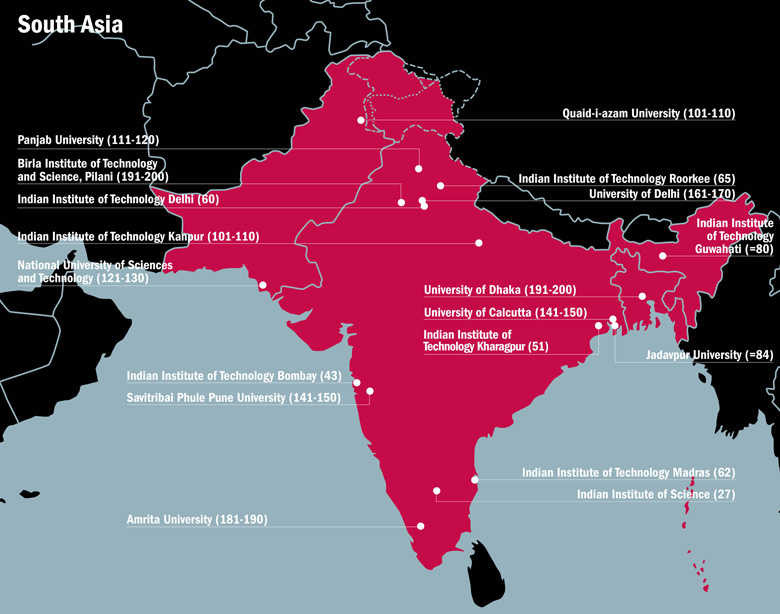Browse the full list of the top 200 institutions in this year's rankings
India is the strongest South Asian nation in the rankings. It is the only country in the region with representatives in the top 100 (eight) and boasts 16 universities overall, while its neighbours Pakistan and Bangladesh have just three institutions between them in the bottom half of the table.
Javed Ashraf, vice-chancellor of Pakistan’s top-ranked institution, Quaid-i-azam University (in the 101-110 band), says that India’s success is partly down to its “stronger tradition of excellence” in academia, while its recent economic development has allowed it to invest more in higher education than its neighbours.
By contrast, he says, his institution is hampered by an infrastructure that “has not kept pace with the size of the student population”.
“We need more space. We need more funds for our laboratories, for our equipment, for our buildings,” he says, adding that the university relies on the government for 60 per cent of its funding.
However, he continues, the institution has “top-rate research” in the natural and biological sciences and its scholars publish in leading academic journals across the globe.
“The quality of the research being conducted at the university is one of our biggest strengths,” he says.
Top universities in South Asia
| South Asia rank | Institution | Country | 2016 Asia Rank |
| 1 | Indian Institute of Science | India | 27 |
| 2 | Indian Institute of Technology Bombay | India | 43 |
| 3 | Indian Institute of Technology Kharagpur | India | 51 |
| 4 | Indian Institute of Technology Delhi | India | 60 |
| 5 | Indian Institute of Technology Madras | India | 62 |
| 6 | Indian Institute of Technology Roorkee | India | 65 |
| 7 | Indian Institute of Technology Guwahati | India | =80 |
| 8 | Jadavpur University | India | =84 |
| =9 | Indian Institute of Technology Kanpur | India | 101-110 |
| =9 | Quaid-i-azam University | Pakistan | 101-110 |
| 11 | Panjab University | India | 111-120 |
| 12 | National University of Sciences and Technology | Pakistan | 121-130 |
| =13 | University of Calcutta | India | 141-150 |
| =13 | Savitribai Phule Pune University | India | 141-150 |
| 15 | Aligarh Muslim University | India | 151-160 |
| 16 | University of Delhi | India | 161-170 |
| 17 | Amrita University | India | 181-190 |
| =18 | Birla Institute of Technology and Science, Pilani | India | 191-200 |
| =18 | University of Dhaka | Bangladesh | 191-200 |
Claim a free copy of the full Asia University Rankings 2016 digital supplement
This is reflected in the university’s high score for research influence: it would be in the top fifth of the table if ranked on this measure alone.
However, Jamil Salmi, former coordinator of the World Bank’s tertiary education programme, says that there is still much room for improvement for the region’s institutions, including those in India.
“India has talked a lot about excellence but has not followed through with large investments, except in the Indian Institutes of Technology subsector. Governance is also a preoccupation, as public universities face the same restrictions as all public institutions in the country,” he says.
“Pakistan had an excellent start in the 2000s, with significant reforms and higher levels of funding. Unfortunately, the political crisis of the past few years has also affected the higher education sector negatively.”
On Bangladesh, he says that the country “has not invested the levels of resources needed for competing internationally, not to mention the high level of politicisation of its public universities”. The main political parties “wage ideological battles through the professors and students’ syndicates”, which can result in frequent industrial action “that disturbs the normal course of studies and research”, he adds.
Ismail Badat, the British Council’s South Asia regional manager for higher and further education, agrees that South Asian universities need to “depoliticise the sector while raising standards of provision and quality assurance mechanisms”.
He adds that governments and industry in the region need to invest greater amounts of funding into research, noting that “while research capacity has been increasing, the proportion of South Asia’s research output compared with the rest of the world is extremely low”.
“In 2013, China produced 71,003 documents with international collaborations, compared to India with 17,484, Pakistan with 4,278, and Bangladesh with 1,566,” Badat says.
“Paradoxically while more countries from outside the region are looking to collaborate on research with South Asian universities, just 2.2 per cent of all international collaborations involve countries within the region.
“Greater research collaboration at a regional level could be a productive first step, in particular to reap the benefits through collaborating on projects that address common, region-specific challenges.”
Despite these concerns, Ashraf says he is optimistic that there will be visible improvements in all the universities in his country in the years to come.
“It is something we are striving for,” he says. “The Higher Education Commission [in Pakistan] has spent a lot of money to improve the academic credentials of faculty across the country.
“Some of our leading universities are already in the range that some Indian universities are at presently.” He adds: “I don’t think we match the very best Indian universities, but I think it is a direction that is plausible and doable.”
POSTSCRIPT:
Print headline: The right direction
Register to continue
Why register?
- Registration is free and only takes a moment
- Once registered, you can read 3 articles a month
- Sign up for our newsletter
Subscribe
Or subscribe for unlimited access to:
- Unlimited access to news, views, insights & reviews
- Digital editions
- Digital access to THE’s university and college rankings analysis
Already registered or a current subscriber?








